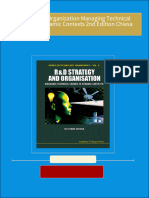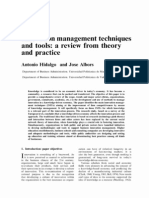Book Review: Innovation Management and New Product Development
Book Review: Innovation Management and New Product Development
Uploaded by
Yahye AbdillahiCopyright:
Available Formats
Book Review: Innovation Management and New Product Development
Book Review: Innovation Management and New Product Development
Uploaded by
Yahye AbdillahiOriginal Title
Copyright
Available Formats
Share this document
Did you find this document useful?
Is this content inappropriate?
Copyright:
Available Formats
Book Review: Innovation Management and New Product Development
Book Review: Innovation Management and New Product Development
Uploaded by
Yahye AbdillahiCopyright:
Available Formats
Int.
Journal of Business Science and Applied Management, Volume 2, Issue 2, 2007
Book Review:
Innovation Management and New Product Development
Fiona Whitehurst
Business School, Newcastle University
Citywall, Citygate, St James Boulevard, NE1 4JH, Newcastle upon Tyne, United Kingdom
Tel: +44 (0)191 2430838
Fax: +44 (0)191 243087
Email: fiona.whitehurst@newcastle.ac.uk
Book Information
Book Title: Innovation Management and New Product Development
Author: Paul Trott
Publisher: Prentice Hall: Financial Times Press, UK
Edition: 3rd edition
Year: 2005
Pages: 536 pages
ISBN: 0-273-68643-7
Price: 44.99
Keywords: innovation management, new product development
Fiona Whitehurst
BOOK REVIEW
This book, written by Paul Trott, an experienced author in the area of innovation management and
a Principal Lecturer at the University of Portsmouth Business School, is aimed at both business and
technology students and has a mission to explain innovation and product development as a
management process encompassing the whole firm, rather than a functional activity reserved for one
department. The key to innovation management is clearly identified in the introductory chapters and
throughout the text as the interaction and flow of knowledge between functions internal to the firm
(including research and manufacturing, marketing and business planning) and the external
environment.
The third edition of this book is significantly restructured into three parts covering innovation
management, managing technology and knowledge, and new product development. The purpose of
each part is clearly explained in a brief introductory summary which also outlines the content of the
chapters within the particular part. Each chapter commences with a clear summary, contents and
learning objectives and concludes with a chapter summary, discussion questions, annotated details of
websites worth visiting, detailed references and recommended further reading.
In the first part of this third edition Trott introduces the conceptual framework which emphasizes
innovation as a management process involving all the internal functions of the firm influenced by
external inputs. He then goes on to explore the role of the state in the innovation process, before
devoting three chapters to the study of innovation management within the firm, covering the way in
which the organisational structure of the firm affects the innovation process, innovation in operations
management and the way in which intellectual property matters affect innovation management and new
product development.
Part two focuses on the management of technology and knowledge and the key question of how to
turn technology into profit. This part includes chapters on strategic alliances and the risks and issues
that arise with them, the role and management of research and development, the difficulties of research
and development project selection and evaluation, and a final chapter examining the role of knowledge
transfer and the issues it raises.
Part three represents a distinctive and especially valuable aspect of the book. In the five chapters
of this part, Trott explores the importance of brand strategy in relation to product development, reviews
the new product development literature and examines models of new product development, introduces
a new chapter on the role of packaging in the new product development process, highlights the ongoing
debates about the use of market research in new product development and concludes by examining the
functioning of the new product development team.
Innovation Management and New Product Development is written in a very readable style with
many real-life examples to illustrate the concepts introduced. New up to date case studies, examples
and illustrations are included in the third edition and this edition has many touches which makes the
text even more accessible and user-friendly. A two-colour design makes the structure of the book
clearer and pause for thought questions are introduced as a pedagogic device to encourage students to
reflect on what they have read. The book is supplemented by substantial internet-based resources for
both lecturers and students.
This book successfully conveys the message that innovation is a complicated, challenging
management process, requiring insights into technology, development, changing markets and
organisational structures. It highlights many practical issues facing firms in their management of the
innovation process and emphasises the topical relevance of many of the matters discussed by
illustrating them with extracts from the Financial Times. When this book was first published in 1998,
Baroness Hogg, in her foreword, noted that the previous year the House of Lords Select Committee on
Science and Technology had held an inquiry into the barriers to the exploitation of scientific ideas and
had recommended that business schools should have a greater role in teaching the management of
innovation. This book is very much written from a business management perspective and, while there
is an ever increasing range of innovation textbooks, I would recommend this book for both
undergraduates and postgraduates with an interest in the management of innovation. It should act as
both a lively textbook during their studies and a useful resource should they be involved in the
management of innovation during their career.
59
You might also like
- The Management of Technological Innovation Strategy and Practice (2008)Document402 pagesThe Management of Technological Innovation Strategy and Practice (2008)Mücahit Çiftlik100% (3)
- Innovation Management & New Product Develpment Trott Ch-1Document16 pagesInnovation Management & New Product Develpment Trott Ch-1Shamsul Alam Sajib67% (3)
- Book Review: Exploring Innovation, by David Smith, Mcgraw Hill EducationDocument8 pagesBook Review: Exploring Innovation, by David Smith, Mcgraw Hill EducationAliaa Ahmed ShemariNo ratings yet
- Characteristics Behaviours of Innovative People PDFDocument63 pagesCharacteristics Behaviours of Innovative People PDFRuben Dario Rodriguez LopezNo ratings yet
- (Bessant Et Al, 2014) Innovation Management, Innovation Ecosystems and Humanitarian Innovation PDFDocument47 pages(Bessant Et Al, 2014) Innovation Management, Innovation Ecosystems and Humanitarian Innovation PDFBernard SarpaNo ratings yet
- Innovation and Firm PerformanceDocument67 pagesInnovation and Firm PerformanceSaad Salih HusseinNo ratings yet
- Total Innovation Management A Novel Paradigm of Innovation Management in The 21st CenturyDocument19 pagesTotal Innovation Management A Novel Paradigm of Innovation Management in The 21st CenturyRomer GesmundoNo ratings yet
- Immediate Download R D Strategy Organization Managing Technical Change in Dynamic Contexts 2nd Edition Chiesa Ebooks 2024Document84 pagesImmediate Download R D Strategy Organization Managing Technical Change in Dynamic Contexts 2nd Edition Chiesa Ebooks 2024khwagazhida100% (11)
- MAPrE 11 M Lesson 1 5Document16 pagesMAPrE 11 M Lesson 1 5Jessica GonzalesNo ratings yet
- The Growth of Firms by Alex CoadDocument208 pagesThe Growth of Firms by Alex Coadthinksmart7No ratings yet
- Where Can Buy The Management of Technological Innovation Strategy and Practice 2nd Edition Mark Dodgson Ebook With Cheap PriceDocument84 pagesWhere Can Buy The Management of Technological Innovation Strategy and Practice 2nd Edition Mark Dodgson Ebook With Cheap Pricestorsdiwane100% (8)
- Download ebooks file R D Strategy Organization Managing Technical Change in Dynamic Contexts 2nd Edition Chiesa all chaptersDocument50 pagesDownload ebooks file R D Strategy Organization Managing Technical Change in Dynamic Contexts 2nd Edition Chiesa all chaptersnellytynchjv100% (2)
- Innovation, Technology & Knowledge ManagementDocument12 pagesInnovation, Technology & Knowledge ManagementsuruboNo ratings yet
- 30 Innovation Management TechniquesDocument15 pages30 Innovation Management Techniquesmkadawi770No ratings yet
- Innovation Management A Research Overview 1st Edition Mark Dodgson All Chapters Instant DownloadDocument29 pagesInnovation Management A Research Overview 1st Edition Mark Dodgson All Chapters Instant DownloadyguhirosiNo ratings yet
- Gestión e Innovación: Un Enfoque Estratégico: January 1997Document7 pagesGestión e Innovación: Un Enfoque Estratégico: January 1997Zarelix Eli ZanabriaNo ratings yet
- 6 Innovation and Supply Chain ManagementDocument353 pages6 Innovation and Supply Chain ManagementThu Vương Thị HươngNo ratings yet
- Innovation, What Innovation? A Comparison Between Product, Process and Organizational InnovationDocument25 pagesInnovation, What Innovation? A Comparison Between Product, Process and Organizational InnovationaccgthryNo ratings yet
- ISE549Document4 pagesISE549vNo ratings yet
- Innovation & Learning OrganizationDocument34 pagesInnovation & Learning OrganizationShyamendra KushwahaNo ratings yet
- ISSN: 2456-3676: The Organizational Culture As A Support of Innovation ProcessesDocument12 pagesISSN: 2456-3676: The Organizational Culture As A Support of Innovation ProcessesMIN THANT ZAW MINNNo ratings yet
- Immediate download Enablers of Organisational Learning, Knowledge Management, and Innovation: Principles, Process, and Practice of Qualitative Data Preethi Kesavan ebooks 2024Document55 pagesImmediate download Enablers of Organisational Learning, Knowledge Management, and Innovation: Principles, Process, and Practice of Qualitative Data Preethi Kesavan ebooks 2024yavarbirchac100% (5)
- 19528Document41 pages19528rodarwhilei3No ratings yet
- Finding the Innovation Gap: Disruptive Idea, a Better Way of Managing Prototypes: Disruptive Idea, a Better Way of Managing PrototypesFrom EverandFinding the Innovation Gap: Disruptive Idea, a Better Way of Managing Prototypes: Disruptive Idea, a Better Way of Managing PrototypesNo ratings yet
- Chiaroni, D., Chiesa, V., & Frattini, F. (2009) - Investigating The Adoption of Open Innovation in The Bio Pharmaceutical IndustryDocument21 pagesChiaroni, D., Chiesa, V., & Frattini, F. (2009) - Investigating The Adoption of Open Innovation in The Bio Pharmaceutical IndustryS martinsNo ratings yet
- (Te Fu Chen) Implementing New Business Models PDFDocument396 pages(Te Fu Chen) Implementing New Business Models PDFdsdamosNo ratings yet
- Syllabus Innovation Management Strategy2013-2014Document7 pagesSyllabus Innovation Management Strategy2013-2014Luis Radd100% (1)
- Ijtm2001specialboer DuringDocument26 pagesIjtm2001specialboer Duringaboadam aliNo ratings yet
- Innovation Management, Innovation Ecosystems and Humanitarian InnovationDocument51 pagesInnovation Management, Innovation Ecosystems and Humanitarian InnovationNguyễn HươngNo ratings yet
- Chiaroni, D. V. Chiesa & F. Frattini, 2010, Unravelling The Process From Closed To Open Innovation Evidence From MatureDocument25 pagesChiaroni, D. V. Chiesa & F. Frattini, 2010, Unravelling The Process From Closed To Open Innovation Evidence From MaturecabalaaNo ratings yet
- European Management Review - 2011 - CANATO - Gurus or Wizards A Review of The Role of Management ConsultantsDocument14 pagesEuropean Management Review - 2011 - CANATO - Gurus or Wizards A Review of The Role of Management Consultantsinesbabouche24No ratings yet
- Full Innovation Management A Research Overview 1st Edition Mark Dodgson Ebook All ChaptersDocument79 pagesFull Innovation Management A Research Overview 1st Edition Mark Dodgson Ebook All Chaptersayazixandy100% (2)
- Efstathiades 2019Document21 pagesEfstathiades 2019Kyriakos ChristofiNo ratings yet
- The Management of Technological InnovationDocument402 pagesThe Management of Technological InnovationJules Seven100% (1)
- How Internal and External Sources of Knowledge Contribute To Firms' Innovation PerformanceDocument23 pagesHow Internal and External Sources of Knowledge Contribute To Firms' Innovation PerformanceKARISHMAATA2No ratings yet
- MTE Chap3 PPT SlidesDocument15 pagesMTE Chap3 PPT SlidesArbresh RaveniNo ratings yet
- Closed Versus Open Innovation: Evolution or Combination?: February 2014Document9 pagesClosed Versus Open Innovation: Evolution or Combination?: February 2014Samudra Putra IndonesiaNo ratings yet
- Innovation management strategies implementation and profits 2nd ed Edition Afuah 2024 scribd downloadDocument85 pagesInnovation management strategies implementation and profits 2nd ed Edition Afuah 2024 scribd downloadartryaduledm100% (17)
- Innovation Management Challenges: From Fads To FundamentalsDocument14 pagesInnovation Management Challenges: From Fads To FundamentalsNinaNo ratings yet
- Innovation and Knowledge CreationDocument11 pagesInnovation and Knowledge CreationCristianNo ratings yet
- Innovation Management and New Product Development Technology and InnovationDocument25 pagesInnovation Management and New Product Development Technology and InnovationandjuliedrosalNo ratings yet
- Entrepreneurship - Creativity and Innovative Business ModelsDocument202 pagesEntrepreneurship - Creativity and Innovative Business ModelsCharmyne De Vera SanglayNo ratings yet
- p1Document9 pagesp1Dhaman GillNo ratings yet
- Author Final Version Final 2Document20 pagesAuthor Final Version Final 2Intissar Ben TekayaNo ratings yet
- 5-2007-Learning From Toyota - How Action Learning Con Foster Competitive Advantage in New Product Development - FuchsDocument58 pages5-2007-Learning From Toyota - How Action Learning Con Foster Competitive Advantage in New Product Development - FuchsCharles CostaNo ratings yet
- Paper87 PID5629739 MartinSoto PushDocument4 pagesPaper87 PID5629739 MartinSoto Pushmsoto20052576No ratings yet
- Technology Management or Management of TechnologyDocument18 pagesTechnology Management or Management of Technologypeter haileNo ratings yet
- Leadership in Enabling and Industrial TechnologiesDocument117 pagesLeadership in Enabling and Industrial TechnologiesHosea HandoyoNo ratings yet
- CH 4 Ofat 732 Qeko 92 Ggrmbha 2 JV 61Document29 pagesCH 4 Ofat 732 Qeko 92 Ggrmbha 2 JV 61Hendry HartonoNo ratings yet
- 00251740910984578Document26 pages00251740910984578luminyiNo ratings yet
- Determination of Portfolio Codes of Ethics in Innovation ManagementDocument11 pagesDetermination of Portfolio Codes of Ethics in Innovation ManagementInternational Journal of Application or Innovation in Engineering & ManagementNo ratings yet
- Malaysian Innovation Ecosystem: A Review of The Literature: January 2014Document13 pagesMalaysian Innovation Ecosystem: A Review of The Literature: January 2014Yogi CNo ratings yet
- A Methodological Approach To The Marketing Process in The Biotechnology-Based CompaniesDocument50 pagesA Methodological Approach To The Marketing Process in The Biotechnology-Based CompaniesabhikaushalNo ratings yet
- Development Through Technology Transfer: Creating New Cultural and Organisational UnderstandingFrom EverandDevelopment Through Technology Transfer: Creating New Cultural and Organisational UnderstandingNo ratings yet
- Regulating Work in Small Firms: Perspectives on the Future of Work in Globalised EconomiesFrom EverandRegulating Work in Small Firms: Perspectives on the Future of Work in Globalised EconomiesIda RegaliaNo ratings yet
- The Innovation Mode: How to Transform Your Organization into an Innovation PowerhouseFrom EverandThe Innovation Mode: How to Transform Your Organization into an Innovation PowerhouseNo ratings yet
- Knowledge Management and Innovation: Interaction, Collaboration, OpennessFrom EverandKnowledge Management and Innovation: Interaction, Collaboration, OpennessNo ratings yet
- Innovation and Transformation: Basics, Implementation and OptimizationFrom EverandInnovation and Transformation: Basics, Implementation and OptimizationNo ratings yet
- PT-2016 V4Document58 pagesPT-2016 V4Yahye AbdillahiNo ratings yet
- Thesis 3Document3 pagesThesis 3Yahye AbdillahiNo ratings yet
- Tesco Real Time SalesDocument4 pagesTesco Real Time SalesYahye AbdillahiNo ratings yet
- Timetable For Full-Time Award Structure (School of Computing and Technology)Document3 pagesTimetable For Full-Time Award Structure (School of Computing and Technology)Yahye AbdillahiNo ratings yet
- UncertaintyModelpaperDocument4 pagesUncertaintyModelpaperYahye AbdillahiNo ratings yet
- Sample Resume - Accounting: David Sze LeeDocument3 pagesSample Resume - Accounting: David Sze LeeYahye AbdillahiNo ratings yet
- BVS Sample Valuation Report 01Document59 pagesBVS Sample Valuation Report 01Yahye AbdillahiNo ratings yet
- 5 CRIMISO GroupProjectDetailsDocument3 pages5 CRIMISO GroupProjectDetailsYahye AbdillahiNo ratings yet
- Report Ontransition From Ipv4 To Ipv6Document20 pagesReport Ontransition From Ipv4 To Ipv6Yahye AbdillahiNo ratings yet
- Name: Yahye Abdillahi Matrix: 209110326Document2 pagesName: Yahye Abdillahi Matrix: 209110326Yahye AbdillahiNo ratings yet
- Final Assignment Presentation Slides FormatDocument31 pagesFinal Assignment Presentation Slides FormatYahye AbdillahiNo ratings yet
- DS Assignment 1Document6 pagesDS Assignment 1Yahye AbdillahiNo ratings yet
- Advanced Database Queries Home Work 3 Part 2Document2 pagesAdvanced Database Queries Home Work 3 Part 2Yahye AbdillahiNo ratings yet
- 02 Syntax SemanticsDocument47 pages02 Syntax SemanticsYahye AbdillahiNo ratings yet
- Carnicom Institute - Research - Paper - ListingDocument12 pagesCarnicom Institute - Research - Paper - ListinggabeNo ratings yet
- Industrial Grinders N VDocument9 pagesIndustrial Grinders N Vapi-250891173100% (3)
- OSINT Curious OSINT Resource ListDocument21 pagesOSINT Curious OSINT Resource ListGioni Pepper100% (1)
- Business Organisation and ManagementDocument108 pagesBusiness Organisation and Managementshekarchittireddy912No ratings yet
- Reflective Lesson Plan (Context Clues)Document6 pagesReflective Lesson Plan (Context Clues)rpaige14No ratings yet
- Tribebook: CroatoanDocument10 pagesTribebook: CroatoanGnomeMadeIon100% (5)
- The Primary KingdomsDocument3 pagesThe Primary KingdomsEzgamApeNo ratings yet
- Meru Tantram Edited by Shrinivas Sharma With Commentary of Kapil Dev Narayan, Vol 2, (9-14) - Chaukhamba Sura Bharati Prakashan, VaranasiDocument9 pagesMeru Tantram Edited by Shrinivas Sharma With Commentary of Kapil Dev Narayan, Vol 2, (9-14) - Chaukhamba Sura Bharati Prakashan, Varanasipvihang21No ratings yet
- 2021 Electric Bond P31430297-P31111441-P31522288Document281 pages2021 Electric Bond P31430297-P31111441-P31522288Dan WestinNo ratings yet
- Tybba (CA) - CA-504 PythonDocument2 pagesTybba (CA) - CA-504 Pythonanomaan563No ratings yet
- Aldar EventsDocument65 pagesAldar EventsReyNo ratings yet
- Letter of Authorization: To Whom It May ConcernDocument1 pageLetter of Authorization: To Whom It May ConcernGarimaSinghNo ratings yet
- Order ListDocument153 pagesOrder ListasifNo ratings yet
- G6 Without STO No Longer Available V001Document8 pagesG6 Without STO No Longer Available V001IRAQI MohsinNo ratings yet
- RIYADH CABLES GROUPCO - Initiation Report PDFDocument29 pagesRIYADH CABLES GROUPCO - Initiation Report PDFikhan809No ratings yet
- Idaho Repository - Case History PageDocument3 pagesIdaho Repository - Case History PageStephenSelf0% (1)
- Handoutspdf PDFDocument49 pagesHandoutspdf PDFashar khanNo ratings yet
- Daniel Demissie FinalDocument63 pagesDaniel Demissie Finalbaya alexNo ratings yet
- PR - Annual Index Review - CAC 40 ESGDocument2 pagesPR - Annual Index Review - CAC 40 ESGpaulouisvergnesNo ratings yet
- Math5 q1 w5 CM, LP, LasDocument11 pagesMath5 q1 w5 CM, LP, LasHerynadel AdvinculaNo ratings yet
- Lesson 4: Mean and Variance of A Discrete Random VariablesDocument11 pagesLesson 4: Mean and Variance of A Discrete Random VariablesIsabella MondragonNo ratings yet
- Chapter 5 CasesDocument21 pagesChapter 5 Casesejusdem generis100% (1)
- Family Members (Part 1)Document4 pagesFamily Members (Part 1)erikaNo ratings yet
- Personal Balanced Scorecard TemplatesDocument4 pagesPersonal Balanced Scorecard Templatesj.faraone21No ratings yet
- Country Risk Map October 2024Document1 pageCountry Risk Map October 2024eunseokyang07No ratings yet
- 1st Assg (Learning Assesment)Document17 pages1st Assg (Learning Assesment)lizajazamNo ratings yet
- HTLA AntibodiesDocument1 pageHTLA Antibodieshakima.hassan.79No ratings yet
- 1-130 Argument New PDFDocument367 pages1-130 Argument New PDFSamyak GoutamNo ratings yet
- Idaho Supreme Court DecisionDocument18 pagesIdaho Supreme Court DecisionThe Salt Lake TribuneNo ratings yet
- Income Tax - Corporations Sample Problems: SolutionsDocument12 pagesIncome Tax - Corporations Sample Problems: SolutionsYellow BelleNo ratings yet







































































































